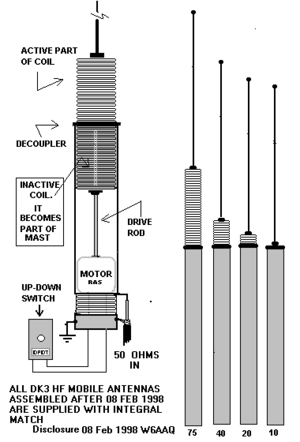Screwdriver antenna
A screwdriver antenna is a vertical antenna with a remotely-adjustable centre-loading coil. Intended for mobile operation, it may be adjusted to cover any band from 10m to 75m. The antenna takes its name from the use of a reversible DC electric motor like that of an electric screwdriver.
The original DK-3 Screwdriver Antenna design was created by Don Johnson W6AAQ, author of a series of three books on "HF mobileering", and was first patented in 1991.
Theory of operation
The screwdriver antenna is based on the use of a loading coil with a whip antenna (typically 102"-120", like those used for 11-metre CB radio installations). It differs in that the loading coil is adjustable to cover multiple HF bands.
The base of the antenna is a hollow tube. The signal is applied to the outside; concealed inside is a reversible DC motor. The motor, operated remotely by a momentary DPDT switch, moves the whip and loading coil so that part of the coil is inside the base (and electrically bypassed, or inactive) and the rest of the coil is in use as a loading coil tuned for the selected band.
When changing frequencies, the antenna loading coil is extended or retracted to tune the antenna to the new band. As this adjusts the inductive loading coil to resonance, no external antenna tuner is required.
References
- HF Mobile On The Shoulders Of Giants, Raymond J. Schneider W6JXW, ARRL, November 1999
- HF Mobileering, KI6LO
- Mobileering Information Page, KG7FU
- Screwdriver Antennas, W6RMK
| Antennas | |
| Design | Beam * Dipole * Dish or Parabola * DDRR * Log Periodic (LPDA) * Loop * Mobile and portable * Omnidirectional * Panel * Quad and Quagi * Screwdriver * Small tuned loop * Vertical * Yagi-Uda * Wire and random wire antennas |
| Installation | Antenna Tuners * Capacity hats and loading coils * Cavity filters * Coaxial Cable * Feedlines * Rotators * Towers and Masts * VK2ACY - G5RV coupler |
| Theory | Front-to-back ratio * Impedance matching * SWR * Tower design * Vertical Antenna efficiency * Wire comparison tables |
